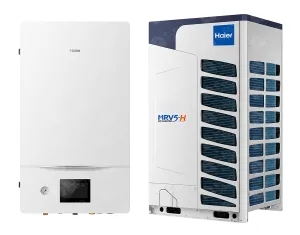Heat pump for cooling
A heat pump for cooling is a remarkable innovation in the realm of climate control, offering the ability to maintain a comfortable indoor environment through efficient utilization of heat from the surrounding atmosphere. With each passing year, interest in such systems surges, and it's perfectly justified: they're not only environmentally friendly but also economically advantageous in the long run.
The operating principle of a heat pump for cooling revolves around the transfer of heat from one medium to another using minimal energy. This is achieved through the utilization of a special refrigerant and a compressor that maintains the appropriate pressure within the system. Thus, a heat pump can effectively cool an indoor space even on the hottest days, without overheating the surrounding environment or placing additional strain on the electrical grid.
One of the primary advantages of heat pumps for cooling is their versatility. They can be used both for cooling spaces during the summer and for heating during the winter period. This makes them an ideal choice for homes, offices, shopping centers, and other facilities with variable needs in terms of climate control equipment.
Furthermore, heat pumps for cooling are characterized by their high energy efficiency. They can convert up to 4 units of heat from the surrounding environment for every unit of electrical energy consumed. This allows for significant savings on electricity bills and reduces the burden on natural resources.
Another advantage of heat pumps for cooling is their reliability and durability. A properly installed and maintained system can operate smoothly for many years, ensuring consistent comfort indoors and minimal maintenance costs.
Additionally, a heat pump for cooling significantly reduces the negative impact on the surrounding environment. Since it utilizes heat from nature as its primary source of energy, emissions of carbon dioxide and other harmful substances are minimal. This makes it one of the most environmentally friendly methods of maintaining a comfortable climate indoors.
Heat pumps for cooling are available in various configurations, allowing for the selection of the optimal solution for specific needs and operating conditions. They can be air-to-air, water-to-water, or ground-source, depending on the availability of different resources and the technical characteristics of the building.
It's important to note that installing a heat pump for cooling requires a professional approach and strict adherence to all technical recommendations. A properly designed and installed system will ensure maximum efficiency and durability of the equipment, as well as minimal operating costs and risks of breakdown.
In conclusion, a heat pump for cooling is a modern and forward-thinking solution for maintaining a comfortable indoor environment. Its advantages include energy savings, environmental safety, reliability, and versatility. A properly selected and installed heat pump will become a reliable partner in maintaining comfortable living and working conditions, while also providing significant economic and environmental benefits.










